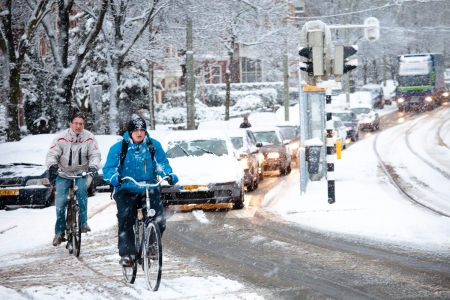Below you will find the list of references that are used in this fact sheet; all sources can be consulted or retrieved. Via Publications you can find more literature on the subject of road safety.
[1]. Jonkeren, O. (2020). De invloed van het weer op de personenmobiliteit. Kennisinstituut voor Mobiliteitsbeleid KiM, Den Haag.
[2]. CROW (2023). Klimaatadaptatie. Kennisplatform CROW. Accessed on 26-05-2023 at www.crow.nl/thema-s/duurzaamheid/klimaatadaptatie.
[3]. CROW (2023). Analyse klimaatadaptatieprojecten ten behoeve van aanpassing richtlijnen. Kennisplatform CROW. Accessed on 26-05-2023 at kennisbank.crow.nl/kennismodule/detail/64189#64189.
[4]. Focant, N. & Martensen, H. (2016). Effects of rain on road safety. European Road Safety Decision Support System, developed by the H2020 project SafetyCube. Accessed on 06-03-2023 at www.roadsafety-dss.eu.
[5]. Malin, F., Norros, I. & Innamaa, S. (2019). Accident risk of road and weather conditions on different road types. In: Accident Analysis & Prevention, vol. 122, p. 181-188.
[6]. KNMI (2023). Zicht. Koninklijk Nederlands Meteorologisch Instituut. Accessed on 26-05-2023 at www.knmi.nl/kennis-en-datacentrum/waarschuwingen/zicht.
[7]. Wu, Y., Abdel-Aty, M. & Lee, J. (2018). Crash risk analysis during fog conditions using real-time traffic data. In: Accident Analysis & Prevention, vol. 114, p. 4-11.
[8]. Yan, X., Li, X., Liu, Y. & Zhao, J. (2014). Effects of foggy conditions on drivers’ speed control behaviors at different risk levels. In: Safety Science, vol. 68, p. 275-287.
[9]. Mueller, A.S. & Trick, L.M. (2012). Driving in fog: The effects of driving experience and visibility on speed compensation and hazard avoidance. In: Accident Analysis & Prevention, vol. 48, p. 472-479.
[10]. Das, A., Ghasemzadeh, A. & Ahmed, M.M. (2019). Analyzing the effect of fog weather conditions on driver lane-keeping performance using the SHRP2 naturalistic driving study data. In: Journal of Safety Research, vol. 68, p. 71-80.
[11]. Theofilatos, A. & Yannis, G. (2014). A review of the effect of traffic and weather characteristics on road safety. In: Accident Analysis & Prevention, vol. 72, p. 244-256.
[12]. Krul, I., Valkenberg, H., Asscherman, S., Stam, C., et al. (2022). Fietsongevallen en snor-/bromfietsongevallen in Nederland - SEH-bezoeken: inzicht in oorzaken, gevolgen en risicogroepen. Rapport 934. VeiligheidNL.
[13]. Schepers, P. & Klein Wolt, K. (2012). Single-bicycle crash types and characteristics. In: Cycling Research International, vol. 2, p. 119-135.
[14]. Woo, B., Kim, H., Kim, J., Baik, H., et al. (2021). Influence of solar glare intensity on vehicular speed variance. In: Journal of Transport & Health, vol. 20, p. 101020.
[15]. Sun, D., El-Basyouny, K. & Kwon, T.J. (2018). Sun glare: Network characterization and safety effects. In: Transportation Research Record, vol. 2672, nr. 16, p. 79-92.
[16]. Mitra, S. (2014). Sun glare and road safety: An empirical investigation of intersection crashes. In: Safety Science, vol. 70, p. 246-254.
[17]. Verbond van Verzekeraars (2015). Spitszon en start schoolseizoen gevaarlijk voor verkeer. Website Verbond van Verzekeraars. Accessed on 09-01-2023 at https://www.verzekeraars.nl/.
[18]. Gariazzo, C., Bruzzone, S., Finardi, S., Scortichini, M., et al. (2021). Association between extreme ambient temperatures and general indistinct and work-related road crashes. A nationwide study in Italy. In: Accident Analysis & Prevention, vol. 155, p. 106110.
[19]. Liang, M., Zhao, D., Wu, Y., Ye, P., et al. (2021). Short-term effects of ambient temperature and road traffic accident injuries in Dalian, Northern China: A distributed lag non-linear analysis. In: Accident Analysis & Prevention, vol. 153, p. 106057.
[20]. Qian, S., Li, M., Li, G., Liu, K., et al. (2015). Environmental heat stress enhances mental fatigue during sustained attention task performing: Evidence from an ASL perfusion study. In: Behavioural Brain Research, vol. 280, p. 6-15.
[21]. FHWA (2023). How Do Weather Events Impact Roads? Federal Highway Administration. U.S. Department of Transportation. Accessed on 26-05-2023 at ops.fhwa.dot.gov/weather/q1_roadimpact.htm.
[22]. Bijleveld, F.D. & Stipdonk, H.L. (2013). De relatie tussen het ingaan van de wintertijd en het aantal verkeersslachtoffers [The relation between the end date of daylight saving time and the number of road traffic casualties. Is there an increase in the number of casualties when the clock is set back one hour?].. R-2013-8. [Summary in English]. SWOV, Leidschendam.
[23]. Strandroth, J., Rizzi, M., Olai, M., Lie, A., et al. (2012). The effects of studded tires on fatal crashes with passenger cars and the benefits of electronic stability control (ESC) in Swedish winter driving. In: Accident Analysis & Prevention, vol. 45, p. 50-60.
[24]. Malmivuo, M., Luoma, J. & Porthin, M. (2017). Studded and unstudded winter tires in fatal road accidents in Finland. In: Traffic Injury Prevention, vol. 18, nr. 5, p. 550-555.
[25]. Hamdar, S.H., Qin, L. & Talebpour, A. (2016). Weather and road geometry impact on longitudinal driving behavior: Exploratory analysis using an empirically supported acceleration modeling framework. In: Transportation Research Part C: Emerging Technologies, vol. 67, p. 193-213.
[26]. Jägerbrand, A.K. & Sjöbergh, J. (2016). Effects of weather conditions, light conditions, and road lighting on vehicle speed. In, vol. 5, nr. 1, p. 505.
[27]. Yang, G., Ahmed, M., Gaweesh, S. & Adomah, E. (2020). Connected vehicle real-time traveler information messages for freeway speed harmonization under adverse weather conditions: Trajectory level analysis using driving simulator. In: Accident Analysis & Prevention, vol. 146, p. 105707.
[28]. Zhao, X., Xu, W., Ma, J., Li, H., et al. (2019). Effects of connected vehicle-based variable speed limit under different foggy conditions based on simulated driving. In: Accident Analysis & Prevention, vol. 128, p. 206-216.
[29]. Guan, W., Chen, H., Li, X., Li, H., et al. (2022). Study on the Influence of Connected Vehicle Fog Warning Systems on Driving Behavior and Safety. In: Journal of Advanced Transportation, vol. 2022, nr. Article ID 8436388.
[30]. KNMI (2023). Uitleg over KNMI waarschuwingen. Koninklijke Nederlandse Meteorologisch Instituut. Accessed on 26-05-2023 at www.knmi.nl/kennis-en-datacentrum/uitleg/knmi-waarschuwingen.
